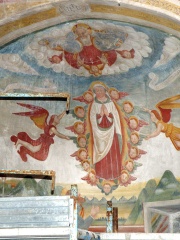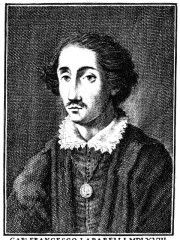RELIGIOUS FIGURE
Junia Tertia
70 BC - 22

 Junia Tertia
Junia Tertia
Junia Tertia, also called Tertulla, (c. 75 BC – 22 AD) was the third daughter of Servilia and her second husband Decimus Junius Silanus, and later the wife of Gaius Cassius Longinus. Read more on Wikipedia
Her biography is available in 15 different languages on Wikipedia. Junia Tertia is the 2,541st most popular religious figure (down from 1,624th in 2024), the 3,287th most popular biography from Italy (down from 2,366th in 2019) and the 516th most popular Italian Religious Figure.
Memorability Metrics
Page views of Junia Tertia by language
Among RELIGIOUS FIGURES
Among religious figures, Junia Tertia ranks 2,541 out of 3,187. Before her are Joseph Höffner, Caterina Volpicelli, Jaime Sin, Justin Welby, Abundius, and Ignatius Gabriel I Tappouni. After her are Giovanni Cagliero, Paul Yoshigoro Taguchi, Austromoine, Elsa Brändström, Patriarch Hermogenes of Moscow, and Nicholas Tavelic.
Most Popular Religious Figures in Wikipedia
Go to all RankingsJoseph Höffner
1906 - 1987
HPI: 57.78
Rank: 2,535
Caterina Volpicelli
1839 - 1894
HPI: 57.77
Rank: 2,536
Jaime Sin
1928 - 2005
HPI: 57.77
Rank: 2,537
Justin Welby
1956 - Present
HPI: 57.76
Rank: 2,538
Abundius
HPI: 57.76
Rank: 2,539
Ignatius Gabriel I Tappouni
1879 - 1968
HPI: 57.76
Rank: 2,540
Junia Tertia
70 BC - 22
HPI: 57.74
Rank: 2,541
Giovanni Cagliero
1838 - 1926
HPI: 57.73
Rank: 2,542
Paul Yoshigoro Taguchi
1902 - 1978
HPI: 57.73
Rank: 2,543
Austromoine
300 - 300
HPI: 57.73
Rank: 2,544
Elsa Brändström
1888 - 1948
HPI: 57.72
Rank: 2,545
Patriarch Hermogenes of Moscow
1530 - 1612
HPI: 57.72
Rank: 2,546
Nicholas Tavelic
1340 - 1391
HPI: 57.72
Rank: 2,547
Contemporaries
Among people born in 70 BC, Junia Tertia ranks 5. Before her are Virgil, Scribonia, Orodes II, and Publius Cornelius Dolabella. Among people deceased in 22, Junia Tertia ranks 1.
Others Born in 70 BC
Go to all RankingsVirgil
WRITER
70 BC - 19 BC
HPI: 88.05
Rank: 1
Scribonia
COMPANION
70 BC - 16
HPI: 73.96
Rank: 2
Orodes II
POLITICIAN
70 BC - 38 BC
HPI: 69.28
Rank: 3
Publius Cornelius Dolabella
POLITICIAN
70 BC - 43 BC
HPI: 68.89
Rank: 4
Junia Tertia
RELIGIOUS FIGURE
70 BC - 22
HPI: 57.74
Rank: 5
Others Deceased in 22
Go to all RankingsIn Italy
Among people born in Italy, Junia Tertia ranks 3,288 out of 5,161. Before her are Riccardo Cucciolla (1924), Giuseppe Signori (1968), Caterina Volpicelli (1839), Eleonora Brown (1948), Guaimar IV of Salerno (1013), and Carlo Orlandi (1910). After her are Pier Andrea Saccardo (1845), Austromoine (300), Francesco Guccini (1940), Maurizio Arrivabene (1957), Francesco Laparelli (1521), and Elio Toaff (1915).
Others born in Italy
Go to all RankingsRiccardo Cucciolla
ACTOR
1924 - 1999
HPI: 57.79
Rank: 3,282
Giuseppe Signori
SOCCER PLAYER
1968 - Present
HPI: 57.78
Rank: 3,283
Caterina Volpicelli
RELIGIOUS FIGURE
1839 - 1894
HPI: 57.77
Rank: 3,284
Eleonora Brown
ACTOR
1948 - Present
HPI: 57.77
Rank: 3,285
Guaimar IV of Salerno
POLITICIAN
1013 - 1052
HPI: 57.76
Rank: 3,286
Carlo Orlandi
BOXER
1910 - 1983
HPI: 57.76
Rank: 3,287
Junia Tertia
RELIGIOUS FIGURE
70 BC - 22
HPI: 57.74
Rank: 3,288
Pier Andrea Saccardo
BIOLOGIST
1845 - 1920
HPI: 57.74
Rank: 3,289
Austromoine
RELIGIOUS FIGURE
300 - 300
HPI: 57.73
Rank: 3,290
Francesco Guccini
SINGER
1940 - Present
HPI: 57.72
Rank: 3,291
Maurizio Arrivabene
BUSINESSPERSON
1957 - Present
HPI: 57.72
Rank: 3,292
Francesco Laparelli
ARCHITECT
1521 - 1570
HPI: 57.71
Rank: 3,293
Elio Toaff
RELIGIOUS FIGURE
1915 - 2015
HPI: 57.70
Rank: 3,294
Among RELIGIOUS FIGURES In Italy
Among religious figures born in Italy, Junia Tertia ranks 516. Before her are Paolo Sardi (1934), Diego Ravelli (1965), Lorenzo Antonetti (1922), Amatus of Montecassino (1010), Fiorenzo Angelini (1916), and Caterina Volpicelli (1839). After her are Austromoine (300), Elio Toaff (1915), Eugenio Tosi (1864), Pietro Palazzini (1912), Severino Poletto (1933), and Edoardo Menichelli (1939).
Paolo Sardi
1934 - 2019
HPI: 58.15
Rank: 510
Diego Ravelli
1965 - Present
HPI: 58.13
Rank: 511
Lorenzo Antonetti
1922 - 2013
HPI: 58.12
Rank: 512
Amatus of Montecassino
1010 - 1090
HPI: 57.90
Rank: 513
Fiorenzo Angelini
1916 - 2014
HPI: 57.86
Rank: 514
Caterina Volpicelli
1839 - 1894
HPI: 57.77
Rank: 515
Junia Tertia
70 BC - 22
HPI: 57.74
Rank: 516
Austromoine
300 - 300
HPI: 57.73
Rank: 517
Elio Toaff
1915 - 2015
HPI: 57.70
Rank: 518
Eugenio Tosi
1864 - 1929
HPI: 57.69
Rank: 519
Pietro Palazzini
1912 - 2000
HPI: 57.55
Rank: 520
Severino Poletto
1933 - 2022
HPI: 57.51
Rank: 521
Edoardo Menichelli
1939 - 2025
HPI: 57.28
Rank: 522



































